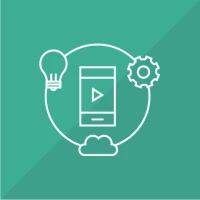A Pivot in the Pandemic
AVID’s investments in digital and data capabilities proved critically important when the COVID-19 pandemic hit. It was late February of 2020, and AVID had just opened registration for its summer training programs, which were expected to draw 40,000 educators; as people continued to register, Thuan Nguyen, the nonprofit’s COO, developed AVID’s COVID-19 response plan and established an emergency command center.
By mid-March, AVID was looking at the potential loss of $30 million in revenue and tens of thousands of educators unprepared for the sudden transition to online school. So the fee-for-service nonprofit pivoted quickly and aggressively, hiring 300 new part-time employees and investing 7,300 hours into developing three different products and offerings:



These underlying strategies and key requirements guided AVID’s development of the new offerings:
- Online learning needed to be redefined; through its digital products and services, AVID could show that high tech is high touch, and can meet students’ social-emotional needs.
- Virtual professional learning must live up to the high standards AVID has set and be applicable to remote, hybrid, blended, and face-to-face classrooms.
- Developing digital products and services would require assembling an expert team that would not attempt to replicate face-to-face professional learning online.
- Measuring the impact of the new products, providing real-time data, and using data for continuous improvement (for both the products and the participants) would be an essential quality-control measure, as well as a competitive advantage.
- Educators would need support throughout the school year—from AVID and a community of their peers—as they apply and practice what they have learned.
- Fees for services should reflect the value AVID provides.
- The entire organization would focus on the new products, pausing other strategic initiatives and operational work.
“Beyond my amazement at how the material was presented virtually in my training, I am thrilled by the content,” said Shelley Mochon, an instructional support teacher at Wood Elementary in Tempe, Arizona. “I keep asking myself, ‘Why am I just now being exposed to AVID, after teaching this long?’ I am eager to revisit the many tools, resources, and ideas shared during this training, and am looking forward to the continued training and collaboration now that I am going to be working in an AVID school.”
How BCG’s Digital and Data Strategy Laid the Groundwork for AVID’s Transformation
AVID was able to build the three new products in 87 days—far faster than it had ever created a single product or service before—because it had laid the groundwork. BCG had worked with AVID in 2018 to help develop AVID’s five-year strategic plan, assisting with the assessment and prioritization of specific growth opportunities. BCG also worked with AVID to define the digital, data, and go-to-market capabilities the nonprofit had to invest in to achieve this growth.
The new digital offerings have been successful by several key measures. In 2020, AVID helped over 130,000 educators—a record number—from more than 4,000 schools to earn over 22,000 digital badges. Teachers reported that they now felt ready to teach virtually; more than 90% of participants said they learned practical instructional strategies that they could implement immediately and that were more engaging, inspiring, and relevant than those offered by other professional learning programs. Specifically, teachers were able to experience firsthand the challenges their students face in a virtual or blended environment—and then learn and practice strategies to help their students.






